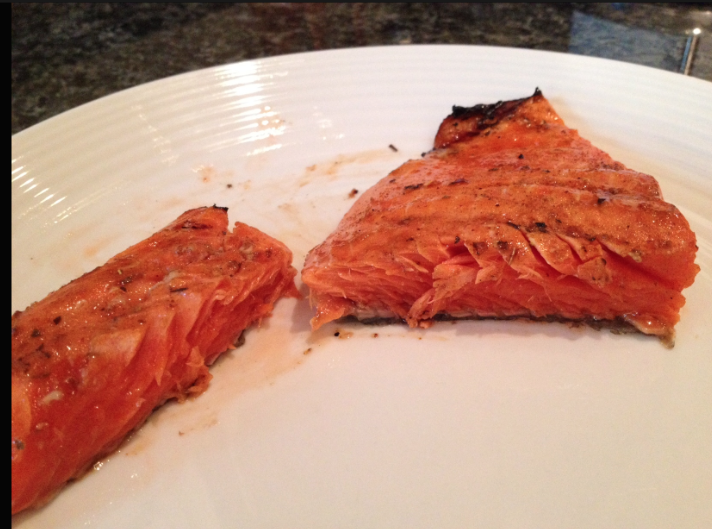Disclaimer. I am not Bobby Flay. I do not make my living in challenging aspiring hipster wannabe chefs to a grilling competition. I have never shouted “Bam!” when throwing a pinch of spices on some food. I do not drive a bright red convertible around the country looking for the most unique diner dish available. However, I have from time-to-time, been known to slowly close my eyes after sampling a dish I created and say something like “Man, that’s righteous. You knocked that one outta the park, Dan.” while giving myself a Guy Fieri-esque fist bump. Now, as we enter Kitchen Stadium let us say, in the words of my father (the chairman)…
Allez Cuisine!
The secret ingredient today is Sockeye Salmon. Okay, so what we’re making today is a grilled sockeye salmon that for the sake of this blog, we’ll call “Wiley’s Finest Grilled Salmon”
Why sockeye? Well, in my humble opinion, the deep red color and high Omega-3 oil content of sockeye salmon (sp. Oncorhynchus nerka) make it a really premium and excellent tasting fish. It’s also very healthy. A 6oz portion of sockeye salmon might have as much as 1500mg of EPA and DHA Omega-3s! Salmon is also a “robust” fish and will stick together when grilling – some species of whitefish and cod tend to flake apart under the stresses of grilling. Of course, this recipe will work any salmon, but make sure that you choose wild-caught Alaskan salmon. This guarantees that you’re sourcing a sustainable, healthy fish for your meal.
Why grilling? The smoke and charring generated during the grilling process adds a unique flavor dimension to the fish without overpowering the natural flavor of the salmon.
Where should you get your sockeye? Sockeye from Alaska’s Copper River salmon run is prized around the world for its flavor and deep red flesh.
Starting in mid-June every year, you can get fresh Copper River sockeye flown in for about 6 weeks or so at most major grocery chains and club stores. The Copper River salmon run is relatively short, so if you’re thinking of skipping that traditional Omega-6 fowl we call a Thanksgiving Turkey this year, you’d best head to the freezer case. I like to get a whole side filet of salmon with the skin on, but in many grocery and club stores, you can buy individually vacuum-packed 6-8oz portions. Try to get frozen portions with the skin still on, as many of the healthy Omega-3 fats lie in the darker flesh right next to the skin. Also, the skin helps to protect the flesh of the fish during grilling, so it acts as a protectant against the high temperatures.
On to the recipe:
Parts List:
- Fresh or Thawed Sockeye Salmon Filet, cut into 6-8oz portions.
- Potlatch Seasoning (make a batch for later use)
- 3 parts chili powder
- 3 parts black pepper
- 1 part ground cumin
- 1 part crushed red pepper flakes
- 1 part celery salt
- 1 part garlic powder
- 1 part onion powder
- 1 part dried oregano
- Kosher Salt
- Maple Syrup (brown sugar will also do in a pinch)
Let’s get started.
Prep the fish. Get it thawed (if frozen), wash it off in cold water, then slice into those 6-8oz portions I mentioned earlier. Pat dry with a cloth towel or paper towel.
Sprinkle kosher salt over one side (flesh side) of the fish. Don’t hit salt on both sides as this can make the fish WAY too salty. Trust me on this one. You want to enjoy your salmon! Then follow that up with a liberal sprinkling of the potlatch seasoning (recipe above). You can rub it in a little to make sure that the flavor takes. Now, let the fish sit and soak in that flavor for a little bit. The salt will tend to pull moisture out of the fish and will wet the spices down nicely. Drizzle maple syrup over the fish and let it sit on a plate. If you don’t have maple syrup, not a problem! You can substitute brown sugar and just rub a nice coating over the fish. Let it all sit for a little while.
Fire up the grill. You can use charcoal or propane. Charcoal will give a more complex, smoky flavor to the meat, but you have to be patient. I’m not a super patient kind of guy, so I prefer propane. Heat the grill up to about 350-400deg F. If it’s the right temperature, you should be able to hold your hand for 3-4 seconds above the grate without pain. Make sure that the grate is scrubbed clean of all the previous day’s grilling residues.
Once you have the grate cleaned off and the grill is nice and hot, put a little bit of oil on the grate. You can put some olive oil on a paper towel and rub it on quickly, or use a spray-can to put a light coat of oil on the grill. This is just to make sure that things don’t stick where they shouldn’t. If the oil burns off in a flaming inferno….the grill is too hot. What you want to see is just a wetting of the grate and maybe a little smoke coming off the grate.
If the grill is greased and the temperature is right, then let’s go fish. Drop those fillets directly on the oiled grate, skin-side down. Turn the heat on “medium” and close the hatch. Let the salmon cook for about 4-5 minutes. (Rule of thumb – 4-5 minutes for about every ½” of fish thickness). After 4-5 minutes has passed, open the hatch and check the cooking progress. At this point, you should see the skin beginning to char and the edges/corners of the salmon starting to turn a golden brown from the caramelized sugars.
At this point, this is a choose-your-own adventure. You can either let the fish ride where it is or flip it over. What I usually do is to flip the fish over and get the searing effect of the hot grill directly on the flesh of the fish. I let it cook like that for maybe another 1-2 minutes and then flip it back on the skin for the final 2-3 minutes. If that’s too dicey for you, then just turn the heat down a hair and let it hang out where it is for another 3-4 minutes.
The fish is done when the outside of the flesh is opaque and moist. It should flake apart easily when you press on the thickest part with a fork. I’m a sashimi fan, so for the most exquisite flavor and texture, the center of the fish should be slightly translucent (medium-rare). However, if the thought of slightly rare fish is a little off-putting…..well, just keep those filets on the grill until the flesh is opaque all the way through. Controlling the cooking end point is tricky without making the fish overdone and dried out, so I always opt for medium rare.
Pair it with some rice or mashed potatoes, steamed asparagus or green beans, and you’ve got a dinner fit for an Alaskan King. Bon Appetit!












